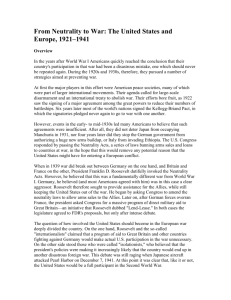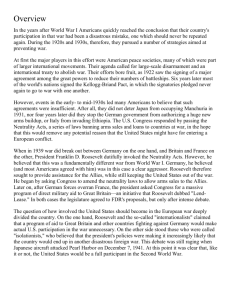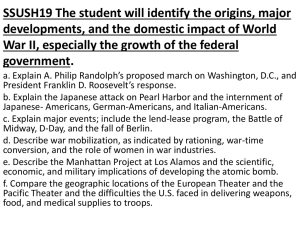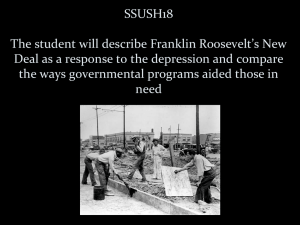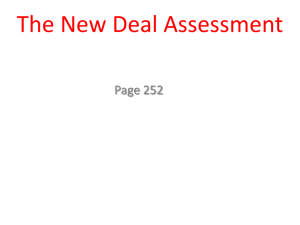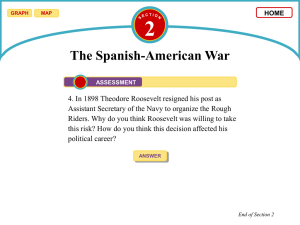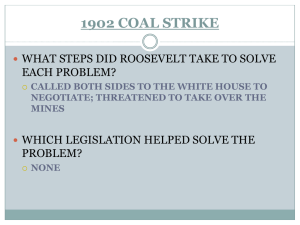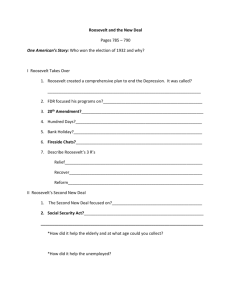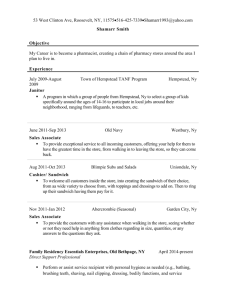Chapter 27 Summary - Biloxi Public Schools
advertisement
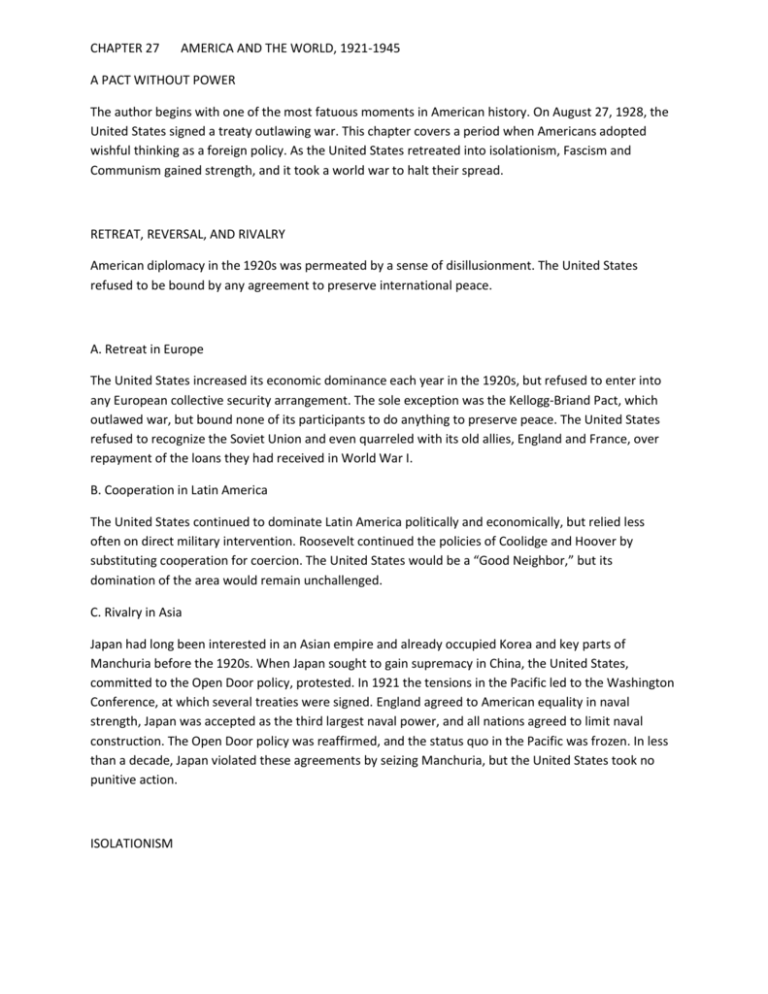
CHAPTER 27 AMERICA AND THE WORLD, 1921-1945 A PACT WITHOUT POWER The author begins with one of the most fatuous moments in American history. On August 27, 1928, the United States signed a treaty outlawing war. This chapter covers a period when Americans adopted wishful thinking as a foreign policy. As the United States retreated into isolationism, Fascism and Communism gained strength, and it took a world war to halt their spread. RETREAT, REVERSAL, AND RIVALRY American diplomacy in the 1920s was permeated by a sense of disillusionment. The United States refused to be bound by any agreement to preserve international peace. A. Retreat in Europe The United States increased its economic dominance each year in the 1920s, but refused to enter into any European collective security arrangement. The sole exception was the Kellogg-Briand Pact, which outlawed war, but bound none of its participants to do anything to preserve peace. The United States refused to recognize the Soviet Union and even quarreled with its old allies, England and France, over repayment of the loans they had received in World War I. B. Cooperation in Latin America The United States continued to dominate Latin America politically and economically, but relied less often on direct military intervention. Roosevelt continued the policies of Coolidge and Hoover by substituting cooperation for coercion. The United States would be a “Good Neighbor,” but its domination of the area would remain unchallenged. C. Rivalry in Asia Japan had long been interested in an Asian empire and already occupied Korea and key parts of Manchuria before the 1920s. When Japan sought to gain supremacy in China, the United States, committed to the Open Door policy, protested. In 1921 the tensions in the Pacific led to the Washington Conference, at which several treaties were signed. England agreed to American equality in naval strength, Japan was accepted as the third largest naval power, and all nations agreed to limit naval construction. The Open Door policy was reaffirmed, and the status quo in the Pacific was frozen. In less than a decade, Japan violated these agreements by seizing Manchuria, but the United States took no punitive action. ISOLATIONISM Americans became even more determined to avoid foreign entanglements in the 1930s, when the Depression made domestic concerns seem more important and when the rise of militaristic regimes in Germany, Italy, and Japan made war seem likely. A. The Lure of Pacifism and Neutrality Most Americans suspected that they had been duped by the munitions makers into going to war in 1917 and resolved never again to fight a meaningless war. Led by Senator Gerald Nye, Congress passed neutrality legislation in 1935 that prohibited U.S. trade with or loans to any nation at war. Roosevelt made no attempt to block this legislation, but refused to invoke the laws when Japan invaded China, thereby allowing China to buy arms from the United States. B. War in Europe Roosevelt generally approved of English and French efforts to appease Hitler, but when Hitler seized Czechoslovakia, FDR attempted to revise the neutrality acts to give an advantage to England and France. Congress, however, refused. By July 1939, Roosevelt openly attacked the neutrality acts, but when World War II began in September 1939, Roosevelt reluctantly declared the acts in force. THE ROAD TO WAR From 1939 to 1941, the American people gave their moral support to England and France and moved slowly into active alliance with them. A. From Neutrality to Undeclared War From 1939 on, Roosevelt led the nation gradually into a position of helping England without actually entering the war. In November, 1939, he persuaded Congress to allow any belligerent to buy American goods on a “cash and carry” basis. When Germany knocked France out of the war in 1940, Roosevelt stepped up aid to England, especially after his election to a third term in 1940. America began to give or loan war supplies to England and even began to transport these goods across the Atlantic, thereby creating incidents with German submarines. The nation debated the neutrality question intensely, and a consensus began to develop that a Nazi victory in Europe would threaten Western civilization. FDR tried to mold public opinion, but feared getting too far in front of it. B. Showdown in the Pacific Japan had added to her conquests while the war raged in Europe. When she invaded and occupied large areas of China, the United States responded by limiting exports to Japan of strategic materials such as oil. This action in no way restrained Japan, who promptly allied herself with Germany and Italy in 1940 and pushed into Indochina. In response, the United States ended all trade with Japan. Japan decided to negotiate with the United States, but to attack her if all Japanese demands were not granted. Japan wanted a free hand in China and the restoration of normal trade relations. The United States demanded that Japan take her troops from China. When diplomacy failed, the Japanese bombed Pearl Harbor on December 7, 1941, in a surprise attack that crippled the Pacific fleet. The next day Roosevelt asked for a declaration of war, and it was granted immediately. Germany and Italy then declared war on the United States. It had taken years for the American people to realize their stake in defeating the Axis powers, but after Pearl Harbor, the American people were united in their determination to win the war. TURNING THE TIDE AGAINST THE AXIS When America came into the war, the Axis was on the offensive everywhere. It took two years before the United States, England, and Russia could seize the initiative, and another two years to crush their enemies. A. Wartime Partnerships One of the greatest advantages the Allies had over the Axis powers was the complete partnership between the United States and England, cemented by the personal friendship between FDR and Churchill. The Soviet Union was less satisfied with the alliance. Despite receiving American supplies, the Soviet Union often felt it was fighting alone against the Germans in Europe. These wartime tensions persisted even after victory. B. Halting the German Blitz The United States agreed to England’s strategy of chewing on the edges of German strength, and invaded North Africa in November 1942. By May, 1943, German troops there had been defeated, and the United States and England invaded Italy. Mussolini fell from power, but the Allies advanced slowly up the peninsula, sustaining heavy casualties. In the meantime, Russia decisively defeated Germany at the battle of Stalingrad and began to push into eastern Europe. C. Checking Japan in the Pacific The conquest of Japan was given second priority, and a two-pronged drive was planned to defeat her. The army under Douglas MacArthur began a drive through New Guinea to the Philippines, while the navy under Chester Nimitz attacked westward from Pearl Harbor, island hopping to the Philippines. After the American victory at Midway in June 1942, U.S. forces moved into Japanese-held territories. THE HOME FRONT The war ended the Depression as American factories began to turn out tanks and aircraft at a tremendous rate. The economy was regulated for a maximum military effort, and scarce items, such as canned food, were rationed for civilians. The war introduced sweeping social changes, as women entered the work force in large numbers, and the move from farm to factory accelerated. T he return of prosperity especially benefitted the lowest-paid wage-earners whose incomes actually rose faster than that of the rich. Since much of the wealth being earned could not be easily spent because of wartime restrictions, the nation’s savings increased rapidly, laying the foundation for postwar prosperity. A. The Arsenal of Democracy The needs of the war effort, especially the need to expand manufacturing, led to profiteering, shortages, and rationing. Roosevelt wanted large tax increases, but Congress balked and the national debt soared. Nevertheless, most Americans saw their incomes rise substantially. B. A Nation on the Move During the war, the American people began to move to the South and West. The war encouraged early marriages and the birth-rate began to climb. The result was a series of problems, such as housing shortages, more divorces, and neglected children. Some groups improved their conditions during the war. Women took jobs formerly reserved for men and saw their incomes rise by 50 percent. African Americans, despite persistent prejudice, demanded and got equal opportunities in war-related industries, which encouraged even greater migration from the rural South. Mexican Americans also migrated to the cities and found factory jobs. One large migration was a forced one. About 120,000 Japanese residents, many of them United States citizens, were moved from the West Coast and placed in detention camps. In 1944, the Supreme Court rejected their appeal for release, but in 1988 the Congress finally acknowledged the injustice that had been done and voted compensation for the survivors of a horrible experience. C. Win-the-War Politics Republicans did well in the 1942 elections and allied with the southern Democrats to control Congress. To regain his party’s moderates, Roosevelt chose Harry Truman as his running mate in 1944, and won a fourth term in office. By that time, however, his health was rapidly deteriorating. After attending the Yalta conference, he died suddenly on April 12, 1945. Harry Truman, totally unprepared, became president. VICTORY After 1943, the Allies began the task of conquering Germany. U.S. and British forces landed in France in June 1944 and in less than a year made a junction with Russian soldiers, who had overrun Germany and taken Berlin. On May 7, 1945, Germany surrendered unconditionally. A. War Aims and Wartime Diplomacy The United States and Russia were divided over what they hoped the war would accomplish. Russia believed that eastern Europe should be her prize for having suffered the most to conquer Germany. The United States wanted a collective security arrangement that included the United Nations. In a series of conferences at Yalta and Potsdam, the differences between the United States and Russia became more evident. B. Triumph and Tragedy in the Pacific In 1944, American forces cleared the Japanese from New Guinea and the Central Pacific, took the Philippines, and began intense air attacks on Japan. Japan’s defeat was inevitable, but would be costly if an invasion had to be launched. On August 6, 1945, the United States used the atomic bomb against Japan. This weapon had taken nearly seven years and billions of dollars to develop. After a second Abomb attack, Japan surrendered on August 14, 1945. CONCLUSION: THE TRANSFORMING POWER OF WAR World War II left the United States as the most powerful nation on earth, with worldwide responsibilities abroad, and at home a legacy of government intervention to improve the lives of its citizens.
